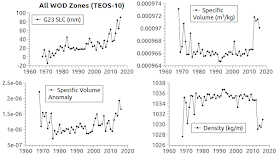 |
| Fig. 1 |
Today, I plan to process them and update the databases, which is a lengthy process.
I also made some headway on a software module that calculates in situ WOD measurements on a "quadrant basis" (NW, NE, SW, and SE) for the WOD geographically oriented data.
 |
| Fig. 2 |
 |
| Fig.3 |
 |
| Fig.4 |
 |
| Fig.5 |
 |
| Fig.6 |
Today's graphs illustrate "The World According To Measurements" concept, which hints that we only know what we measure in terms of ocean reality.
Some things we don't know because we haven't been there to measure yet.
That doesn't mean that we can't reasonably estimate what we haven't measured yet, but it does mean that we must take special care when doing so.
The graph at Fig. 1 is the mean average of the quadrants with a focus on a new try-out of volume and density algorithms in the TEOS-10 toolkit.
I am seeing relationships that can be revealing in three TEOS-10 functions.
The gsw_specvol, gsw_specvol_anom_standard, and gsw_rho results are shown in Fig. 1.
Navy oceanographers have this to say about those concepts:
"The density of seawater is function of temperature, salinity, and pressure. It increases with increasing salinity and pressure, and decreases with increasing temperature. The density is expressed in units of kg/m3, or sometimes g/cm3.(Navy). The take home from this is that when density is increasing the thermosteric volume is decreasing.
Oceanographers use a number of different ways to express the density of seawater, so you may see the terms density anomaly, potential density, (pronounced sigma-theta), specific volume, specific volume anomaly or others. The most commonly used of these are defined below.
Specific volume is the inverse of density; It has dimensions of volume/mass, units of m3/kg, cm3/g, or centiliters per metric ton (cliter/ton) are usually used, where 1 cliter/ton=10-5 cm3/g.
Specific volume (steric) anomaly, , is the difference between the in situ specific volume and the specific volume of seawater at the same pressure with S = 35 and T = 0°C.
The specific volume anomaly analogy is called the
thermosteric anomaly."
These TEOS-10 functions can help keep a check and balance on the formula I use (V1 = V0 * (1 + B * DT) to calculate thermal expansion and contraction.
Let's get back to the graphs.
While Fig. 1 focuses on volume and density (mass) issues, the other graphs (Fig. 2 - Fig. 6) show the traditional Conservative Temperature (CT) and Absolute Salinity (SA) values, including a look at them in the NW, NE, SW, and SE quadrants.
The PSMSL component of today's graphs is the often used "Golden 23" selection (Golden 23 Zones Revisited, Golden 23 Zones Meet TEOS-10).
I will post graphs on the quadrants that will show all of the information discussed above at three depth layers (0 - 700m, >700m - 2000m, and > 2000m) after I process the data updates.
The case against the notion that "thermal expansion is the major factor in sea level rise" is getting stronger by the day.
I will post the results of the data updates soon.
The next post in this series is here, the previous post in this series is here.
Pretty nice post. I just stumbled upon your weblog and
ReplyDeletewished to say that I've truly enjoyed browsing your blog posts.
In any case I'll be subscribing to your feed and I hope you write again soon!
Ahaa, its pleasant conversation concerning this article at this place at this web site, I have read
ReplyDeleteall that, so now me also commenting here.
I am actually delighted to read this web site
ReplyDeleteposts which contains tons of helpful data, thanks for providing these kinds of data.
This website definitely has all the info I needed about this subject and didn't know who to ask.
ReplyDelete